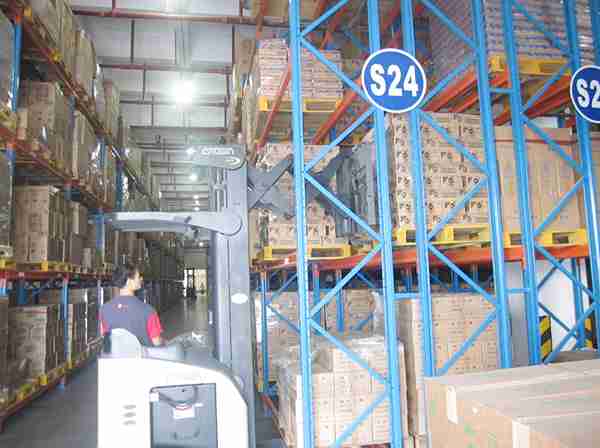📐 "First 50 Enterprise Queries Get Custom 3D Warehouse Design" Plan

Introduction: Why Proper Leveling of Double Deep Pallet Racks is Non-Negotiable
In industrial warehouses and distribution centers, double deep pallet racks are the backbone of high-density storage systems. However, their structural integrity depends entirely on one critical factor: proper leveling of double deep pallet racks. When racks aren’t leveled correctly, the consequences can be catastrophic—collapsed loads, forklift accidents, and even OSHA violations.
This definitive guide dives deep into the best practices for leveling double deep pallet racks, offering warehouse managers and logistics professionals a step-by-step methodology to ensure perfect alignment, long-term durability, and operational safety.

H1: The Science Behind Properly Leveling Double Deep Pallet Racks
H2: How Improper Leveling Leads to Structural Failure
Unlike single-deep racks, double deep pallet racks carry significantly more weight and require precise leveling to prevent:
- Rack collapse due to uneven load distribution
- Forklift misalignment, increasing the risk of impacts
- Premature wear on uprights and beams
- Violations of ANSI MH16.1 and OSHA standards
H2: The Physics of Load Distribution in Double Deep Systems
Because double deep pallet racks store pallets two-deep, the center of gravity shifts further back, making leveling double deep pallet racks even more critical than in single-deep configurations. Even a 1-degree tilt can cause:
- Beam deflection under heavy loads
- Upright frame twisting over time
- Increased stress on anchor bolts
H1: The Step-by-Step Process for Leveling Double Deep Pallet Racks
H2: Step 1 – Conduct a Thorough Floor Inspection
Before leveling double deep pallet racks, the floor must be assessed for:
- Concrete cracks or settlement (use a laser level to check flatness)
- Slope variations (maximum allowable: 1/8″ per 10 feet)
- Debris or obstructions that could interfere with base plates
Pro Tip: If the floor is uneven, self-leveling epoxy or steel shims must be used before proceeding.
H2: Step 2 – Assemble Uprights with Precision
- Follow manufacturer torque specifications for anchor bolts
- Use a plumb bob to ensure perfect vertical alignment
- Shim as needed—never force uprights into position
H2: Step 3 – Install and Align Beams for Optimal Load-Bearing
- Double-check beam connectors for secure fastening
- Verify levelness with a digital inclinometer
- Adjust with shims if beams are not perfectly horizontal
H2: Step 4 – Perform a Stability Test Before Loading
- Apply slight pressure to test for wobbling
- Re-torque all bolts after initial adjustments
- Conduct a forklift trial run to ensure smooth access
H1: Common Mistakes in Leveling Double Deep Pallet Racks (And How to Avoid Them)
H2: Mistake #1 – Using Inferior or Incorrect Shims
- Plastic shims compress over time, leading to instability
- Solution: Only use galvanized steel shims for permanent adjustments
H2: Mistake #2 – Ignoring Manufacturer’s Leveling Guidelines
- Each double deep pallet rack system has unique specs
- Solution: Always refer to the installation manual before leveling
H2: Mistake #3 – Skipping Post-Installation Inspections
- Racks settle over time, requiring ongoing adjustments
- Solution: Schedule quarterly inspections to maintain perfect leveling
H1: Advanced Techniques for Maintaining Perfectly Leveled Double Deep Pallet Racks
H2: Using Laser Alignment for Industrial-Grade Precision
- Laser levels provide 0.01° accuracy, far superior to spirit levels
- Ideal for large-scale warehouses with hundreds of rack bays
H2: Dynamic Load Testing for Long-Term Stability
- Simulate maximum capacity loads to test leveling integrity
- Helps identify potential weak points before they fail
H2: Implementing a Preventative Maintenance Schedule
- Bi-annual inspections for high-traffic warehouses
- Annual inspections for lighter-use facilities
H1: When to Call a Professional for Leveling Double Deep Pallet Racks
While many warehouses handle basic leveling in-house, experts should be consulted when:
- Racks show signs of twisting or bending
- Floors have severe unevenness (>1/4″ slope)
- Modifications involve reconfiguring entire rack systems
Conclusion: The Lifespan of Your Double Deep Pallet Racks Depends on Proper Leveling
Leveling double deep pallet racks isn’t just a one-time task—it’s an ongoing commitment to safety and efficiency. By following the methods outlined in this guide, warehouses can:
✔ Prevent costly accidents and OSHA fines
✔ Extend rack lifespan by decades
✔ Optimize storage density without compromising safety
For further reading, explore our guides on choosing the right pallet rack shims and OSHA compliance for warehouse racking.
FAQs: Expert Answers on Leveling Double Deep Pallet Racks
1. How do I know if my double deep pallet racks need re-leveling?
Look for visible tilting, beam sagging, or forklift misalignment.
2. Can I use wooden blocks instead of shims for leveling?
Never. Wood deteriorates and compresses, making it unsafe for leveling double deep pallet racks.
3. What’s the most accurate tool for checking rack leveling?
A laser level or digital inclinometer provides the highest precision.
4. How much does professional rack leveling cost?
Prices range from 2,000 depending on warehouse size and rack complexity.
5. Does OSHA require documentation for rack leveling?
Yes, OSHA 1910.176(b) mandates records of inspections and adjustments.




